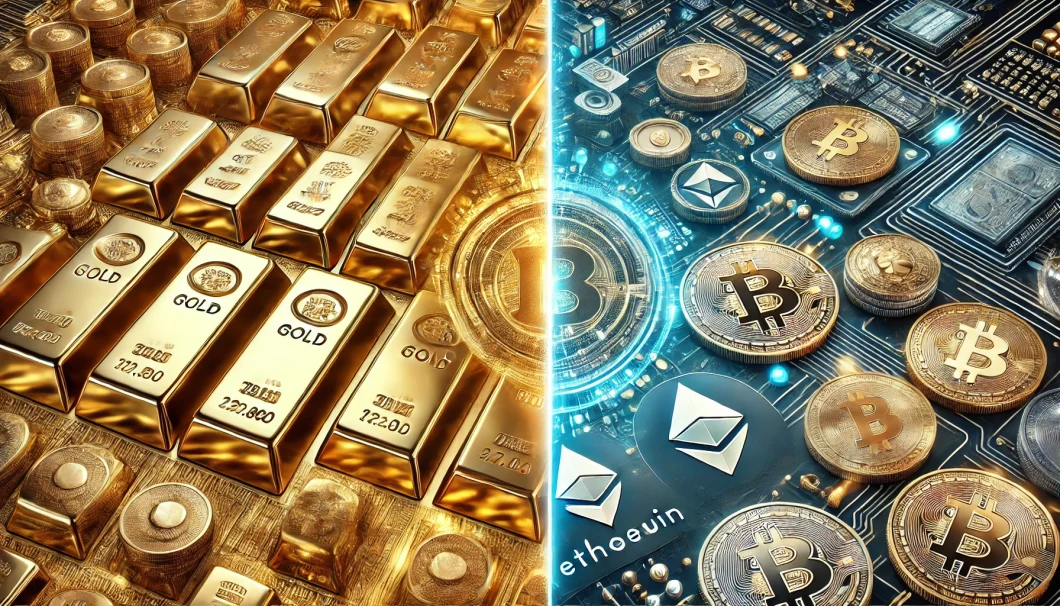
In today’s rapidly evolving financial landscape, the debate between precious metals vs cryptocurrency has become increasingly prominent. Both assets have garnered attention as alternative investments, with investors seeking refuge from traditional financial systems and the potential to hedge against economic uncertainties. This blog post delves into the history, benefits, and drawbacks of precious metals and cryptocurrency, offering insights into how these two investment vehicles compare in the modern world.
Historical Significance of Precious Metals
Precious metals, particularly gold and silver, have been treasured for millennia. Their intrinsic value and rarity have made them symbols of wealth and power throughout history. Ancient civilizations like the Egyptians, Greeks, and Romans used gold and silver not only as currency but also for ornamental purposes and religious artifacts. Gold coins became a staple of trade and commerce, and by the Middle Ages, gold was the standard for determining the value of currencies.
The Gold Standard, established in the 19th century, further solidified gold’s position in the global economy. Under this system, a country’s currency was directly linked to a specific amount of gold, ensuring that money had a tangible value. Although the Gold Standard was abandoned in the 20th century, the allure of gold and other precious metals as safe-haven assets has persisted, especially during times of economic turmoil.
Emergence of Cryptocurrency
Cryptocurrency, in contrast, is a relatively recent phenomenon. The concept of digital currency can be traced back to the late 20th century, but it wasn’t until 2009 that Bitcoin, the first decentralized cryptocurrency, was introduced by an anonymous entity known as Satoshi Nakamoto. Bitcoin’s revolutionary blockchain technology, which allows for secure and transparent peer-to-peer transactions without the need for intermediaries, quickly gained attention.
The success of Bitcoin paved the way for the creation of thousands of other cryptocurrencies, each with its own unique features and use cases. Ethereum, for example, introduced smart contracts, while Ripple focused on facilitating fast and low-cost international payments. As of today, the cryptocurrency market has grown into a multi-trillion-dollar industry, attracting a diverse range of investors from around the globe.
Value Proposition of Precious Metals
One of the primary reasons investors flock to precious metals is their historical stability. Gold and silver have consistently held their value over time, making them reliable stores of wealth. During periods of inflation or currency devaluation, precious metals often perform well as they are seen as a hedge against economic uncertainty. Additionally, tangible assets like gold and silver are not subject to the same risks as digital assets, such as hacking or technological failures.
Another advantage of precious metals is their physical nature. Investors can hold gold and silver in their hands, which provides a sense of security that digital assets may not offer. Furthermore, precious metals have industrial applications, particularly in electronics and manufacturing, which adds to their intrinsic value.
Value Proposition of Cryptocurrency
Cryptocurrency offers a different kind of value proposition. The decentralization of cryptocurrencies like Bitcoin means they are not controlled by any government or central authority, making them immune to traditional financial system failures or manipulation. This independence appeals to those who seek financial sovereignty and privacy in their transactions.
Another key benefit of cryptocurrency is its potential for high returns. While the market is known for its volatility, early adopters of Bitcoin and other major cryptocurrencies have seen significant gains. Additionally, the blockchain technology underpinning cryptocurrencies has the potential to revolutionize various industries, from finance to supply chain management, which adds to the long-term value of these digital assets.
Risk Factors
While both precious metals and cryptocurrency offer unique benefits, they are not without risks. Precious metals, though stable, are often criticized for their lack of yield. Unlike stocks or bonds, gold and silver do not generate income, which can be a drawback for investors seeking cash flow. Additionally, the value of precious metals can be influenced by geopolitical factors, such as mining regulations or central bank policies, which may lead to price fluctuations.
Cryptocurrency, on the other hand, is notorious for its volatility. The value of digital assets can swing dramatically in short periods, leading to potential losses for investors. The regulatory environment for cryptocurrency is also uncertain, with many governments still grappling with how to classify and regulate these digital assets. Furthermore, the security risks associated with cryptocurrency, such as hacking or loss of private keys, remain a significant concern.
The Future of Precious Metals
The future of precious metals largely depends on global economic conditions and investor sentiment. In times of crisis, gold and silver will likely continue to serve as safe-haven assets, offering protection against inflation and currency devaluation. However, the growth of digital assets and changing investor preferences may challenge the dominance of precious metals in the investment landscape.
There is also the potential for innovation within the precious metals market. For instance, the rise of digital gold, where gold is tokenized and traded on blockchain platforms, could merge the best of both worlds by providing the security of gold with the flexibility of cryptocurrency.
The Future of Cryptocurrency
Cryptocurrency’s future is closely tied to technological advancements and regulatory developments. As blockchain technology matures, it is expected to become more integrated into everyday financial systems, potentially leading to wider adoption of digital currencies. However, this growth is contingent on overcoming current challenges, such as scalability, energy consumption, and regulatory acceptance.
The increasing interest from institutional investors and the development of central bank digital currencies (CBDCs) also suggest that cryptocurrency could play a more significant role in the global financial system in the coming years. However, whether cryptocurrencies can achieve the same level of trust and stability as precious metals remains to be seen.
Conclusion
When comparing precious metals and cryptocurrency, it is essential to recognize that these assets serve different purposes within an investment portfolio. Precious metals offer stability and a hedge against economic uncertainties, making them a reliable store of value. Cryptocurrency, on the other hand, provides the potential for high returns and financial independence, albeit with higher risk.
Investors should consider their risk tolerance, investment goals, and the broader economic environment when deciding between these two asset classes. For many, a diversified approach that includes both precious metals and cryptocurrency may offer the best of both worlds, providing stability and growth potential in an increasingly complex financial landscape.
In the end, the choice between precious metals and cryptocurrency will depend on individual preferences and the evolving nature of the global economy. By understanding the strengths and weaknesses of each, investors can make informed decisions that align with their financial objectives and risk tolerance.

